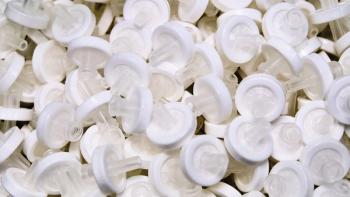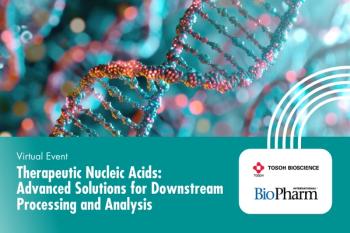
- BioPharm International-02-01-2014
- Volume 27
- Issue 2
Advances in UPLC Techniques and Column Chemistry Aid the Confirmation of Biosimilarity
Automated sample handling, advanced glycan analysis and specially designed columns are helping biosimilar manufacturers speed up confirmation of the biosimilarity of their products.
In addition to comprehensively characterizing the physicochemical/structural properties of a biosimilar protein/glycoprotein (APIs and formulated therapeutics), manufacturers of biosimilars must demonstrate comparability to the innovator biologic. Biosimilarity is achieved by tweaking the production process until it yields a product that is similar to the innovator drug as determined through extensive characterization. Initially, batches of the innovator molecule are evaluated to determine the exact amino acid sequence, any post-translational modifications, and the level of structural attribute variability over time. Once manufactured, the structure of the biosimilar must then be confirmed and the data compared directly with that of the innovator protein. “Demonstrating a high level of similarity between the biosimilar and the branded drug can have a big impact on the approval process for the biosimilar; fewer differences translate to lower risk and the opportunity for reduction of clinical experience needed for approval,” notes Scott Berger, senior manager for the Pharmaceutical and Life Science Team at Waters Corporation.
As a result, tests must be carried out to determine the molecular weight and size, amino acid sequence and composition, the peptide map, including the location of sulfhydryl group(s) and disulfide bridges, other post-translational modifications, such as deamidation and oxidation, the degree of heterogeneity, the carbohydrate structure, the pegylation pattern, and impurity and degradation profiles. Various analytical fingerprints must also be obtained, including the electrophoretic and liquid chromatographic patterns and various spectroscopic (e.g., ultraviolet-visible, circular dichroism) profiles. Numerous orthogonal techniques are used for these analyses to more definitively detect any differences in the biosimilar and branded biologic, and many of them involve separation via high-performance liquid chromatography (HPLC) or, more frequently today, ultra high-pressure liquid chromatography (UHPLC).
Need for multiple chromatographic modes
One of the biggest challenges that biosimilar manufacturers face is the need to do extensive monitoring of product attributes using multiple modes of liquid chromatography throughout the development process, including peptide mapping, charge variant assays, ion exchange (IEX), and size exclusion chromatography (SEC) to name a few, according to Berger.
The first hurdle is accurately deformulating the innovator drug without affecting the structure of the protein, which often is very sensitive to the environment. Many analytical methods cannot be carried out directly using the formulated drug because the presence of surfactants, carriers, and other ingredients can influence the results. “The chemist needs to be aware of these potential issues, particularly if the analyses will be carried out at different pH and ionic strength levels than the formulated product. Orthogonal methods are particularly valuable at this stage,” Berger notes.
For Daniel Peckman, manager of the Biochemistry Department at Eurofins Lancaster Laboratories, the major question that must first be answered prior to developing an HPLC method is ‘What attributes of the biologic need to be evaluated?’ “The biosimilar may have unique properties that should be considered, such as undergoing undesired changes or modifications during production that might impact how it functions as a therapeutic. Therefore, the goal is to develop a method for monitoring that change in comparison to a standard over time. A more in-depth method, like liquid chromatography followed by mass spectrometry, may be warranted in such a case.”
Sample prep control crucial
Ensuring consistent sample preparation is crucial for protein analyses for the same reason. Even slight variations in environmental conditions or sample properties may affect the results, both during method development and biosimilar analyses. Perturbations such as freeze-thaw cycles can lead to protein aggregation, for example, according to Peckman. Control of pH, salt content, and concentration is also important. One way to address this issue, according to Berger, is to use automated mobile phase mixing methodologies/approaches. “Not only does a properly designed, automated system enable robust method development with consistent and reproducible results, it can lead to increased productivity.”
For biotherapeutic analysis, Waters’ Auto-BlendPlus Technology uses pure solutions and concentrated stocks and calculates the percentage of each to achieve the desired system conditions over a wide range of pH and salt concentrations and gradients so that variations in the buffer solution can be minimized. The system, according to Berger, ernables researchers to efficiently explore separation spaces and is effective for the optimization of IEX methods for charge variant separations.
Using columns designed for higher resolution protein separation
Higher resolution is often needed for biosimilar analysis due to the high complexity of many biotherapeutics and the need to separate closely related product variants. “UHPLC provides superior resolution of variants and greater sensitivity for more in-depth protein characterization,” says Berger. He stresses, though, that combining UHPLC with columns designed specifically for protein analysis is important for obtaining the maximum resolution and ideal selectivity for the analysis.
Column selection can be tricky, however, depending on the nature of the biologic. “The key is to select a column that provides adequate separation and performs consistently over time,” notes Peckman. “One question to ask is ‘What column chemistry will give acceptable separation of the protein impurities and still yield a good mass balance of loaded sample?’ In other words, several HPLC columns may successfully bind and elute the protein of interest, but the best choice will be the column that repeatedly elutes all the protein injected, the same way each time it is used.”
Carryover of residual protein on the HPLC column can also be an issue and typically results because the interaction between the protein and the column packing is too strong. Several things can be attempted to manage this problem, according to Peckman, including selection of a less-aggressive column packing, adjustment of the initial concentration of the mobile phase, and using more aggressive gradient elution percentages.
“HPLC column manufacturers have really begun to focus on protein-related HPLC and are specifically designing columns that address the particular challenges associated with the analysis of biologics,” says Peckman. Examples include column packings that are stable at elevated pH, which has historically not been the case in protein chromatography. He also notes that new column packings have been developed that provide good separation while limiting non-specific binding, and columns that have historically been used for traditional chromatography are now available in versions that allow higher resolution separations and faster methods.
In fact, there are application-specific columns available for ion exchange, size exclusion, reversed phase, affinity, and hydrophilic-interaction chromatography (HILIC). The Protein separation technology (PrST) columns from Waters, for example, are based on a core ethylene-bridged hybrid (BEH) particle designed to separate immunoglobulins and other recombinant therapeutics with high resolution while minimizing unwanted secondary interactions that can lead to column carryover, according to Berger.
Keep it simple for best results
Making minor adjustments to methodologies once an effective system has been established and not introducing more variables into the equation through sample mishandling are two key factors for success in biosimilar analysis, according to Peckman. He also recommends trending the data closely so sample stability can be established early. Using traditional methods, such as reversed-phase and size-exclusion chromatography, for purity assessment, but applying more in-depth techniques, particularly mass spectrometry (MS)-driven approaches, for the determination of slight modifications has also been effective for him. Peckman also notes that the more data points the better, and significant information can be gained by performing degradation studies on the biologic and then evaluating which methods show the resulting changes with reproducibility.
Tackling the challenge of glycan analysis
Glycan analyses can be particularly challenging given their diversity and complexity, but recent UHPLC/mass spectrometry solutions developed by professor Pauline M. Rudd at the National Institute for Bioprocessing Research and Training (NIBRT) in Dublin, Ireland are changing that. “UHPLC is ideal for biosimilar analysis and confirmation of biosimilarity because it is high resolution and very sensitive (to 0.1 to 0.5% of total glycans). It is also robust and highly reliable, provides quantitative data, and is much less expensive than MS. The system we developed was also purposely designed to be easy to use and can be operated in a manufacturing environment,” Rudd notes. The flow-through from the UHPLC can also be analyzed directly using on-line MS and MS2 to give confirmation of the LC data.” She also notes that the latest Waters software enables these orthogonal sets of data to be conveniently compared in the same screen.
Detailed analysis of glycan pools involves the identification of the oligosaccharides present, including their monosaccharide sequences and linkage characteristics and the stereochemistry and level of branching. Rudd’s team has shown that HILIC chromatography enables the most complete glycan separation of both charged and neutral glycans in a single run, including structural isomers, while weak anion-exchange (WAX) and reversed-phase (RP) chromatography provide important specific information because they resolve the glycans on a different basis. Rudd notes that amplification of the signal by means of stoichiometric derivatization with the fluorescent tag 2-aminobenzamide for fluorescence detection prior to UHPLC analysis is advantageous because the relative amounts of the glycans can be determined. When a similarly labeled dextran ladder (poly-glycose) external standard is used, glucose units (GU) can be derived from the calibrated retention times. GU values for glycans are stable from day-to-day and allow accurate comparisons of HILIC data derived from different instruments. Furthermore, structural information can be obtained from the shift in the GU value if UHPLC analysis is performed after digestions of aliquots of the glycan pools with exoglycosidase arrays. These enzymes specifically cleave the glycosidic bonds of individual terminal monosaccharide units.
Rudd and her colleagues at NIBRT developed GlycoBase, a database that includes HILIC and MS data on more than 400 2-aminobenzamide-labeled N-linked glycans and 75 O-glycan structures, and GlycoExtractor, a web-based tool for the extraction of large volumes of processed glycan profile data. A low-cost, automated N-glycan analysis platform for the high-throughput glycoprofiling of all glycoproteins including immunoglobulin G antibodies (IgG) has also recently been described (1). This platform enables rapid IgG affinity purification and sample concentration, protein denaturation, glycan release, and fluorescent labeling on a 96-or 384-multiwell filtration device. Glycan purification is carried out on solid-supported hydrazide, and the released and labeled glycans are quantified by UHPLC. “Using this high-throughput workflow, it is now possible to profile immunoglobulin glycans as well as glycans attached to other biopharmaceuticals efficiently, rapidly, and relatively cheaply,” Rudd asserts.
Waters has incorporated the UHPLC glycan GU database and automated analysis platform developed by NIBRT into its suite of tools for glycan characterization and detailed analysis. “With the new Glycan Application Solution with UNIFI biosimilar manufacturers can achieve automated, high-confidence glycan structural assignments,” notes Berger. Adds Rudd: “This system will also be compliant with the guidelines of the MIRAGE (Minimum Information Required for a Glycomics Experiment) project that is being developed by glyco-analytics and bioinformatics experts from around the world.”
Reference
1. H. Stockmann et al., Anal. Chem. 85(18), 8841−8849 (2013).
Articles in this issue
almost 12 years ago
Novel Expression Systems Opening CMO Opportunitiesalmost 12 years ago
EMA Collaborates with HTA Assessment Networksalmost 12 years ago
Tackling the Challenge of HOS Determinationalmost 12 years ago
The Affordable Care Act's Impact on Innovation in Biopharmaalmost 12 years ago
Cytotoxicity Risks in Single-use Media and Bioreactor Containersalmost 12 years ago
Defining Quality Metrics is No Easy Taskalmost 12 years ago
BioPharm International, February 2014 Issue (PDF)Newsletter
Stay at the forefront of biopharmaceutical innovation—subscribe to BioPharm International for expert insights on drug development, manufacturing, compliance, and more.




